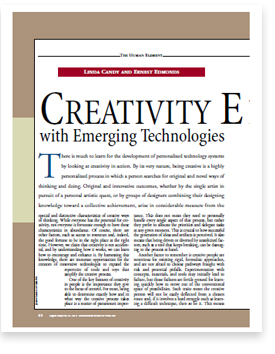There is much to learn for the development of personalized technology systems by looking at creativity in action. By its very nature, being creative is a highly personalized process in which a person searches for original and novel ways of thinking and doing. Original and innovative outcomes, whether by the single artist in pursuit of a personal artistic quest, or by groups of designers combining their designing knowledge toward a collective achievement, arise in considerable measure from the special and distinctive characteristics of creative ways of thinking. While everyone has the potential for creativity, not everyone is fortunate enough to have these characteristics in abundance. Of course, there are other factors, such as access to resources and, indeed, the good fortune to be in the right place at the right time. However, we claim that creativity is not accidental, and by understanding how it works, we can learn how to encourage and enhance it. By harnessing this knowledge, there are immense opportunities for the creators of innovative technologies to expand the repertoire of tools and toys that amplify the creative process.
One of the key features of creativity in people is the importance they give to the locus of control. For most, being able to determine exactly how and in what way the creative process takes place is a matter of paramount importance. This does not mean they need to personally handle every single aspect of that process, but rather they prefer to allocate the priorities and delegate tasks at any given moment. This is crucial to how successful the generation of ideas and artifacts is perceived. It also means that being driven or diverted by unsolicited fac-tors, such as a tool that keeps breaking, can be damag-ing to the process at hand. [ p.62]
The article suggests that a holistic strategy which combines developing technology alongside creative action to produce technology that can play a part in extending the boundaries of human though and action.


Most Commented